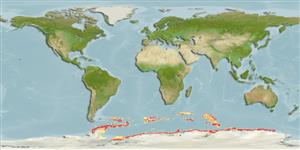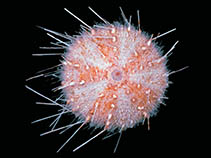Sterechinus antarcticus Koehler, 1901
| Native range | All suitable habitat | Point map | Year 2050 |

|
| This map was computer-generated and has not yet been reviewed. |
| Sterechinus antarcticus AquaMaps Data sources: GBIF OBIS |
Classification / Names Common names | Synonyms | CoL | ITIS | WoRMS
Echinoidea | Camarodonta | Echinidae
Environment: milieu / climate zone / depth range / distribution range Ecology
Benthic; depth range 450 - 2081 m (Ref. 84841). Polar
Distribution Countries | FAO areas | Ecosystems | Occurrences | Introductions
Antarctic.
Length at first maturity / Size / Weight / Age
Maturity: Lm ? range ? - ? cm
Life cycle and mating behavior Maturity | Reproduction | Spawning | Eggs | Fecundity | Larvae
Main reference
References | Coordinator | Collaborators
Gutt, J., I. Barratt, E. Domack, C. d'Udekem d'Acoz, W. Dimmler, A. Gremare, O. Heilmayer, E. Isla, D. Janussen, E. Jorgensen, K.H. Kock, L.S. Lehnert, P. Lopez-Gonzales, S. Langner, K. Linse, M.E. Manjon-Cabeza and M. Meißner 2011 Biodiversity change after climate-induced ice-shelf collapse in the Antarctic. Deep Sea Research Part II 58:74-83. (Ref. 87520)
IUCN Red List Status
(Ref. 130435: Version 2025-1)
CITES status (Ref. 108899)
CMS (Ref. 116361)
Threat to humans
Human uses
| FishSource |
Tools
More information
Diet composition
Food consumption
Predators
Max. ages / sizes
Length-weight rel.
Length-length rel.
Length-frequencies
Mass conversion
Abundance
Internet sources
BHL | BOLD Systems | CISTI | DiscoverLife | FAO(Publication : search) | Fishipedia | GenBank (genome, nucleotide) | GloBI | Gomexsi | Google Books | Google Scholar | Google | PubMed | Tree of Life | Wikipedia (Go, Search) | Zoological Record



